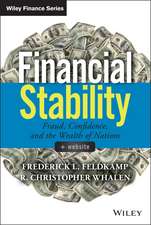Credit Risk Management in the Automotive Industry: Structuring of loan and lease securitizations as integrative solution
Autor Alexander Heneren Limba Engleză Paperback – 30 mar 2005
Preț: 380.25 lei
Nou
Puncte Express: 570
Preț estimativ în valută:
72.77€ • 75.54$ • 60.68£
72.77€ • 75.54$ • 60.68£
Carte tipărită la comandă
Livrare economică 22 martie-05 aprilie
Preluare comenzi: 021 569.72.76
Specificații
ISBN-13: 9783824482870
ISBN-10: 3824482878
Pagini: 188
Ilustrații: XIX, 166 p. 1 illus.
Dimensiuni: 148 x 210 x 10 mm
Greutate: 0.23 kg
Ediția:2005
Editura: Deutscher Universitätsverlag
Colecția Deutscher Universitätsverlag
Locul publicării:Wiesbaden, Germany
ISBN-10: 3824482878
Pagini: 188
Ilustrații: XIX, 166 p. 1 illus.
Dimensiuni: 148 x 210 x 10 mm
Greutate: 0.23 kg
Ediția:2005
Editura: Deutscher Universitätsverlag
Colecția Deutscher Universitätsverlag
Locul publicării:Wiesbaden, Germany
Public țintă
ResearchCuprins
1 Introduction.- 2 The Automotive Industry.- 2.1 Relevance of the Industry and of the Captive Financial Companies.- 2.2 Risk Management in Industry and Commerce.- 2.3 Stakeholders in the Automotive Industry.- 2.4 Summary.- 3 Credit Risk Models.- 3.1 Model Requirements in the Automotive Industry.- 3.2 Elements of Credit Risk Modeling.- 3.3 Model Selection.- 4 CreditRisk+ and the Regulatory Model.- 4.1 The Original CreditRisk+ Model.- 4.2 Framework of CreditRisk+.- 4.3 Extensions of CreditRisk+.- 4.4 Implementation of CreditRisk+.- 4.5 The Regulatory Model.- 5 Credit Risk Management.- 5.1 Risk Measures and Contributions.- 5.2 Portfolio Risk Measures and Contributions in CreditRisk+.- 6 A Model for Securitization.- 6.1 Capital and the Management of Financial Institutions.- 6.2 Securitization.- 6.3 Securitization in the Automotive Industry.- 6.4 A Model for the Securitization of Car Financing Contracts.- 6.5 Regulatory Framework.- 7 Empirical Analysis.- 7.1 Implementation.- 7.2 Data Information and Manipulations.- 7.3 Results.- 7.4 Conclusion.- 8 Summary and Topics for Future Research.- Appendix: Explicit Calculations for the CR+ Model.- Appendix: Abbreviations.- Appendix: Variables.
Notă biografică
Der Verfasser promovierte extern bei Prof. Dr. Johannes Schneider am Lehrstuhl für Volkswirtschaftslehre, insbesondere Wirtschaftstheorie, der Katholischen Universität Eichstätt. In dieser Zeit war er als Doktorand am Forschungszentrum von DaimlerChrysler in Ulm tätig.
Textul de pe ultima copertă
One of the reasons for the expected increase in the number and volume of German asset-backed securities (ABS) transactions is the True-Sale Initiative fostered by the Kreditanstalt für Wiederaufbau. The question is, which particular contracts from a pool of finance or lease contracts should be securitized in an ABS transaction.
Focusing on captive finance units in the automotive industry the author analyzes this question. He shows which interest groups and potential conflicts may cause portfolios to be inefficiently priced, and suggests securitization as an integrative solution. Taking the issuer's point of view he develops a quantitative framework for the structuring of ABS transactions. In order to determine the risk contributions of individual contracts in the portfolio, the author examines the feasibility of various credit risk models. The securitization framework and the credit risk model are implemented and parameterized.
Focusing on captive finance units in the automotive industry the author analyzes this question. He shows which interest groups and potential conflicts may cause portfolios to be inefficiently priced, and suggests securitization as an integrative solution. Taking the issuer's point of view he develops a quantitative framework for the structuring of ABS transactions. In order to determine the risk contributions of individual contracts in the portfolio, the author examines the feasibility of various credit risk models. The securitization framework and the credit risk model are implemented and parameterized.
Caracteristici
Securitization as an integrative solution









